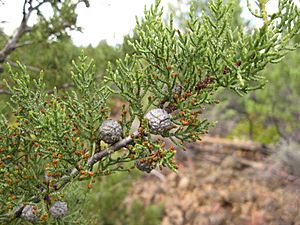Cupressus bakeri facts for kids
Quick facts for kids Cupressus bakeri |
|
|---|---|
 |
|
| Conservation status | |
| Scientific classification | |
| Genus: |
Cupressus
|
| Species: |
bakeri
|
 |
|
| Natural range | |
| Synonyms | |
|
|
The Baker cypress (also called Modoc cypress or Siskiyou cypress) is a special kind of cypress tree. Its scientific name is Hesperocyparis bakeri. This tree is quite rare. It grows only in a small part of northern California and southwestern Oregon in the western United States.
Contents
Where the Baker Cypress Lives
This tree grows in a small area. You can find it in northern California. It lives in Siskiyou, Modoc, Shasta, Plumas and Tehama Counties. It also grows in a very small part of southwestern Oregon. This includes Josephine and Jackson Counties.
You usually find these trees in small groups. They do not form large forests. They grow at high places, from about 900 to 2,000 meters (3,000 to 6,600 feet) above sea level. This includes areas like the Modoc Plateau and the southern Cascade Range. You can also find them in the Klamath Mountains and the northern Sierra Nevada.
The Baker cypress grows slowly in nature. It mostly lives in places where other plants struggle to grow. These tough spots include serpentine soils and old lava flows. Because it can handle these difficult places, it avoids competition. It doesn't have to fight with faster-growing trees for space or sunlight. It often grows in chaparral (shrubland) and Yellow pine forest areas.
What the Baker Cypress Looks Like
The Baker cypress, or Hesperocyparis bakeri, is an evergreen tree. This means it keeps its leaves all year round. It has a cone-shaped top. It can grow from 10 to 25 meters (33 to 82 feet) tall. Some rare ones can reach 39 meters (130 feet). Its trunk can be up to 50 centimeters (20 inches) wide. Very old trees can have trunks up to 1 meter (40 inches) wide.
The leaves are small and look like scales. They are 2 to 5 millimeters long. They grow on round branches, not flat ones. The leaves can be dull gray-green or a pretty blue-green color. They have a very strong, pleasant smell.
The tree produces seed cones. These cones are round or slightly oval. They have bumpy, sticky spots called resin glands. They are 10 to 25 millimeters long. Each cone has 6 or 8 scales, but sometimes 4 or 10. When they first grow, they are green to brown. After about 20 to 24 months, they turn gray or gray-brown. The male cones are smaller, about 3 to 5 millimeters long. They release pollen in February or March.
The cones often stay closed for many years. They usually only open after the parent tree dies in a wildfire. This allows the seeds to spread onto the burnt ground. This helps new trees grow where the fire cleared space.
Protecting the Baker Cypress
The Baker cypress is a vulnerable species. This means it is at risk of disappearing. It is listed on the IUCN Red List. For many years, people tried to stop all wildfires. This was called "fire suppression." But the Baker cypress needs fire to reproduce. Its cones open after fires, letting seeds grow. Because fires were stopped, new Baker cypress trees have not been able to grow as much. This has made it harder for the species to survive.
Images for kids



